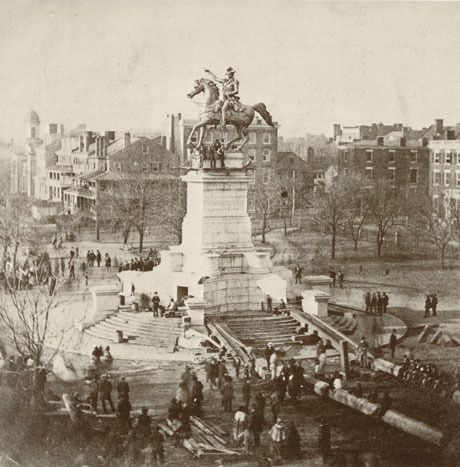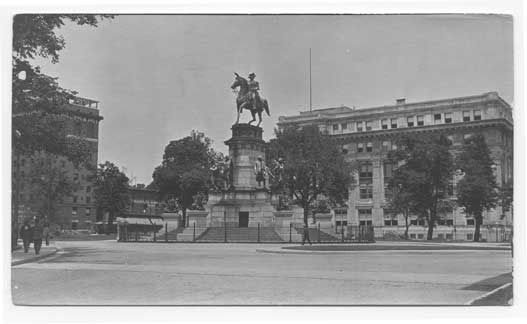@Setanta,
Buses have wheels, and I don't see circles where the wheels should be...
I think you are wrong.
@iGeo,
I believe its modern because of the dog on leash. and the two light standards. They dont look like gas lamps.
@iGeo,
I think you are deluding yourself because you want to believe it is from the era of the American civil war. If those are not buses, what do you say they are? If you don't see wheels, that's just more evidence of the poor quality of the sketch.
@saab,
According to the Wikipedia article linked here, the first reliable electric trolley system in the world was in Richmond in 1888. Before that, they had horse-drawn trolleys. He doesn't see any wheels, i don't see any horses.
@Setanta,
I'm not deluding myself. I mentioned that they are consistent with the era. I also mentioned how it could be from a much later era. I don't make any conclusions about the era from which they are from. The part I do not see is the bus, which is what I am disagreeing with. Is the bus there? They look like parts of a building. I could say that it's just as delusional to see a bus...
The two best sources for Richmond during that war are A Rebel war clerk's diary at the Confederate States capital [sic], John Beauchamp Jones, Lippincott, New York, 1866; and Mary Chestnut's diary, published variously, and first published by D. Appleton and Company, New York, 1905, as "A Diary from Dixie." Her personal papers were discovered in 1949, and C. Vann Woodward published an expanded and annotated version in 1981 as Mary Chestnut's Civil War, Yale University Press, 1981. Woodward won the Pulitzer prize for history for that work. It has been called a true work of art and the best Confederate book ever written. (Although that's not necessarily a sterling accolade.)
Neither book mentions street cars, which does not, of course, prove anything.
@iGeo,
You're seeing what you want to see. You think your way, and i'll think mine.
@farmerman,
Good points, but I'm not entirely sure on that.
I believe dogs were on leashes since their domestication, much like how horses were harnessed and "leashed" soon after domestication. Man's best friend for thousands of years must have been leashed as common practice early on, and I don't think that's a modern phenomenon - leash requirements may be a different and more modern issue, along with the decrease in stray dogs that were probably a prolific issue in cities the world over for centuries.
Here's a pic of a military service dog in the Civil War with a leather leash pulled taut, provided in the link below.
http://www.thedogpress.com/SideEffects/Civil-War-Dogs_Lanting-126.asp
Here's a 19 C period photo of a gas street lamp that looks similar to the street lamp's profile drawn in the sketch.
https://upload.wikimedia.org/wikipedia/commons/1/12/Charles_Marville,_Place_de_l'Op%C3%A9ra,_1878.jpg
@iGeo,
maybe youre right about the dog(or whatever that blob is)> Your gas lamps are very different than those shown in the sketch. Gas lamps needed to have a "chimney, the lamps in the sketch are round GLOBES, an electricity thing. AND since elctricity needed AC setups for long transmission lines, AC was mostly a 20th century thing
ALSO the staue in the square at Richmond has an equestrian AND 4 "angels at each corner of the wide pedestal. This one is totally different.
@farmerman,
Perhaps you're right about the lamps - I'll have to look into that some more. My initial thoughts would be that gas lamps may want to utilize globed profiles to enhance lighting. But I'm unsure on that. Maybe globed fixtures were used as an avante garde style to introduce electricity to the world. The 1893 Chicago World's Fair was the first major public showing of electricity, and you can see from this image from the link below how the globed electric street lights prominently light up the streets. That said, I'm unsure if globed fixtures were new or were simply less popular due to its awkwardly different design compared to everything else before (it may make more sense to use a "modern" globe design with new technology such as electricity, though globed glass mixed in with traditional style fixtures may have been used for gas lit street lights - not sure).
http://haygenealogy.com/hay/1893fair/1893fair-night3.jpg
The GW iMonument in Richmond had statues of other Founding Fathers placed there in 1869. It didn't have those in place when the GW statue was originally erected in 1858, hence my thoughts of the sketch's era.
1858

1869

@iGeo,
who's the 1858 equestrian ? I dont think it George. Its almost post Civil war looking
@iGeo,
I'm curious why you think this is American at all.
@iGeo,
the sketch doesn't really reflect much in the link
see Bobsal's notes
@ehBeth,
theres a key in equestrian statues. If the horse is rearing or if its running> I dont know where that is. We can interpret the "hero being honored"
@farmerman,
there's a statue that could be mistaken for that about every 200 - 300 km in Ontario but the plaza seems pretty European
(the sketch could easily be a modern one from Quebec City)
@ehBeth,
Dead guys on horses are a very popular way to honor them.
@farmerman,
yup
just did a look around - there seem to be hundreds in Eastern Europe
__
also flashing back to the great sculpture gardens at Brookgreen Gardens near Myrtle Beach
https://www.brookgreen.org/sculpture.html